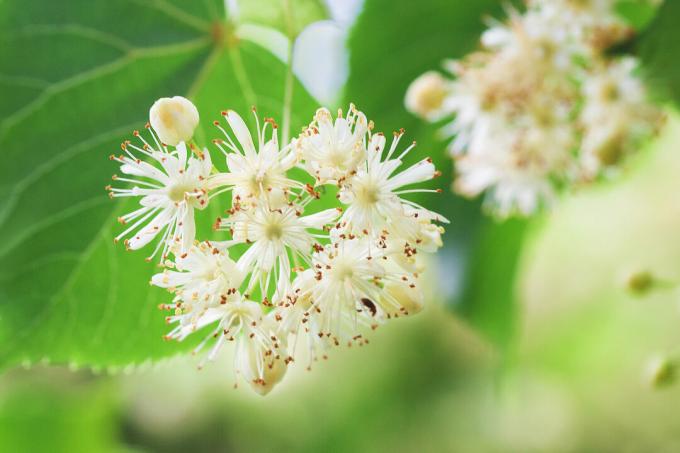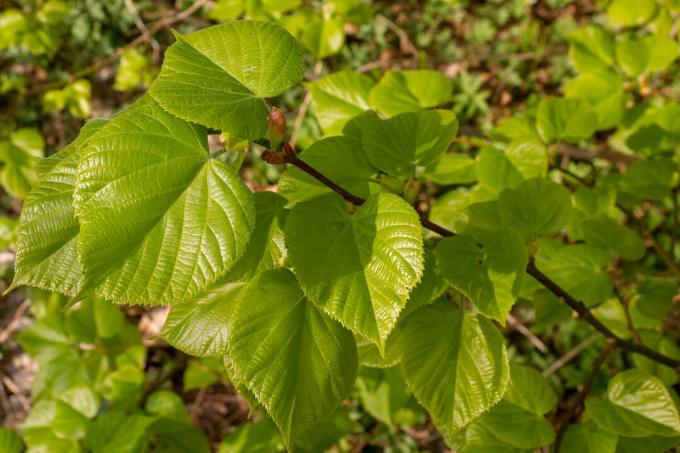800 years ago, Hildegard von Bingen recommended putting linden leaves on your face to get a good night's sleep. Today, the diverse healing effects of linden blossoms and leaves have also been partially scientifically confirmed.

There linden trees (Tilia) are among the most common city trees, the linden blossom in June and July is almost unmissable. At this time, the trees give off a pleasant scent and are filled with a continuous humming and humming, because linden trees are one of the most important honey-producing plants. But lime trees not only have a lot to offer for bees, lime blossoms and leaves are also extremely healthy for us humans and can be used in many ways. In this article you will find out whether you can eat the different parts of linden trees, when to harvest linden blossoms and what linden blossom tea is good for. Everything to Cultivation and care of linden trees we have, however, summarized them in a separate article for you.
contents
- Are linden flowers and linden leaves edible?
- Collect and use linden blossoms
- Harvest and use linden leaves
- effect of the linden tree
Are linden flowers and linden leaves edible?
You can eat both linden blossoms and linden leaves. Linden leaves, for example, are excellent in a salad and linden blossoms are very popular as a decoration for dishes and of course for linden blossom tea. But you can also eat the fruits of the linden tree, which provide valuable fatty acids. Shortly after flowering, they are still soft, but become harder and harder as they mature, especially in the case of the small-leaved lime. Even then, the linden fruits can still be peeled and then, for example, nibbled raw or used as a side dish in a salad.

Tip: There are about 50 types of linden, but only for flowers and leaves of small-leaved linden (Tilia cordata) and small-leaved linden (Tilia platyphyllos) a medical effect is confirmed. Therefore, before collecting, find out what kind of linden tree you are dealing with. For example, silver linden blossoms and leaves (Tilia tomentosa).
Collect and use linden blossoms
If you are sure that your linden tree is a large-leaved or small-leaved linden tree, collecting linden blossoms is not particularly difficult. It just takes a bit of time, but rewards you with your own supply of linden blossom for next year.

What you need to consider when harvesting and drying linden blossom
- When do you harvest linden blossoms? 1 - 4 days after the start of flowering in full bloom. Small-leaved lindens flower slightly earlier than small-leaved lindens. Lime trees bloom between June and July.
- Pick linden blossoms including the light-colored bracts and the flower stalks.
- Drying: gently, turning several times in a shady place. If necessary, dry at 45 °C - this works well in a dehydrator, for example.
- Storage: dark and dry, no longer than a year.
After collecting, linden blossoms can be used in many ways. The best known is probably the linden blossom tea. For this, either two teaspoons of fresh or one teaspoon of dried linden blossoms are poured over a cup of hot water. Then let it steep for 5 to 10 minutes and strain.

You can also use linden blossoms for a cold brew, make linden blossom syrup and tinctures from them, or use the blossoms for relaxing baths and for inhaling. If you let the syrup thicken a little longer, some people even refer to it as vegan “lime blossom honey”, i.e. as a vegan honey substitute. Lime blossom tinctures are also used today in a variety of ways to make cosmetics such as creams, facial tonics or soaps.
Linden blossoms have even been used in gynecology for a long time. Linden blossoms can be helpful during pregnancy, as they relieve anxious tension and can make childbirth easier.
Tip: It is sometimes recommended not to exceed a daily dose of two to three cups. Apparently, however, no side effects of linden blossoms and leaves are known. Therefore, approach consumption carefully and do not overdo it, because as with any food, excessive consumption could lead to problems. Above all, however, if you are pregnant or if children are taking lime blossom tea, it should be advisable to consult your doctor.

Harvest and use linden leaves
If you want to dry and store linden leaves, only fully developed linden leaves should be harvested. The best time to harvest is therefore between June and August.
Since aphids and the honeydew they produce often cling to the leaves, the leaves should be washed first. Here, too, the harvested crop should first be gently dried in the shade, which may be followed by artificial drying at 45 °C. The same applies to the storage of dried linden leaves as to linden blossoms, because this should be done in a dark and dry place and last a maximum of one year. You can also make tea from linden leaves, but here, for example, the sweat-inducing effect has not been convincingly confirmed. External use is more common with linden leaves – decoctions with linden leaves can be used as a poultice for various skin diseases.

Young leaves can be used in many ways when fresh. Their taste is pleasant and sweet, so they can be used in large quantities in salads or green smoothies. And as Hildegard von Bingen recommended, linden leaves are also helpful for tired eyes. For example, if your eyes are strained from sitting in front of the screen or reading, you can you put some fresh linden leaves on your eyes overnight and with a light sleeping mask fix.
effect of the linden tree
Since linden blossoms and leaves are natural remedies, the effects mentioned here are evidenced more by empirical values of centuries of use than by scientific studies.
Lime blossoms contain many health-related substances. These include, for example, saponins, tannins and mucilage, essential oils and, above all, a high content of flavonoids. Thanks to these ingredients, lime blossom is said to have various effects, some of which we have summarized here in a short list:
- expectorant
- Sweaty
- reassuring
- Slightly hypotensive
- cough stimulant
- anti-inflammatory
Because of these effects, linden blossom tea is called Herb against colds, for fever, diseases of the upper respiratory tract, rheumatism and some other complaints.

In the case of leaves, the content of ingredients is more location- and season-dependent. They stand out above all for their high content of tannins, but they also contain various sugars, healthy fats and enzymes. A high content of vegetable mucilage is also sometimes mentioned, which gives soups a nice, creamy consistency, among other things. As already mentioned, the effects of linden leaves are less well studied than those of linden flowers. But even if the effect of linden leaves is less sweaty than that of the flowers, linden leaf extracts can be used for sore throats, for example.
If you are now considering planting a lime tree in your garden, you will find more information in our article on the Planting, cutting and propagating lime trees.
